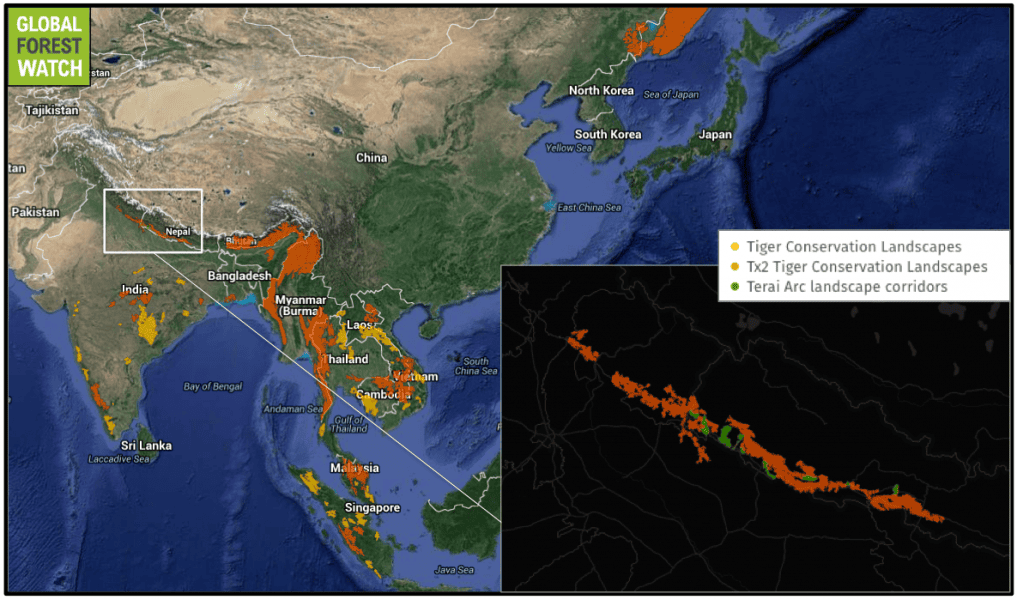- In response to dwindling tiger numbers, countries put forth a goal of identifiying and protecting enough remaining habitat to double the tiger population by 2022.
- Although around 7 percent of forest cover was lost throughout tiger habitat, researchers say they expected that number to be higher given the large human populations and economic growth in many parts of tiger range. Their findings support the feasibility of the 2022 goal.
- But threats persist, particularly in areas with high levels of industrial agriculture such as palm oil plantations that can usurp tiger habitat. Poaching and the loss of prey animals are also big drivers of tiger decline.
According to a new study published recently in the journal Science Advances, the latest technology in satellite imagery shows that there is still enough habitat in the wild for tiger range countries to meet the global target of doubling the world’s tiger population by the year 2022.
The study was conducted by researchers from the University of Minnesota, the collaboration non-profit RESOLVE, Smithsonian Conservation Biology Institute, Rainforest Alliance, Stanford University and World Resources Institute (WRI). They found that with some strengthening of conservation investment, enough habitat protection and requisite measures taken to protect wild tigers (Panthera tigris), Asia’s largest cat might no longer be threatened with extinction.
Using the latest in satellite monitoring and imagery, researchers analyzed 14 years’ worth of high-resolution global forest loss data obtained for 76 landscapes that have been prioritized for tiger conservation spanning 13 tiger range countries. In addition to updating existing global information on the status of tiger habitat, the analysis also represents a new application of real-time technology that can now detect exactly where forest loss is occurring so as to subsequently help curb future habitat loss.
Tigers have disappeared from more than 90 percent of their original habitat range, with a 42 percent decline just since 2006. In 2010, the generally accepted size of the famed feline’s wild global population stood at less than 2,200 individuals. In response, Russia held a high-level summit at which nations with tigers met to tackle the problem and try to grow their populations. They agreed on a goal they termed “Tx2” that aims to double the global tiger number by 2022.

But when tigers have access to quality habitat and abundant prey, and when they are well-protected from the ever-present danger of illegal hunting, their populations have been known to rebound quickly. Since the meeting in Russia, Nepal and India – both tiger range countries – have reported 61 and 31 percent increases in their tiger populations, respectively (although the latter remains contested). According to the research team, these increases are, in-part, due to conservation initiatives like preservation of the cross-boundary Terai Arc Landscape – a region of the Himalayan foothills in Nepal and India comprising 14 protected ecosystems.
For countries to achieve the Tx2 goal, researchers say significant efforts will have to be made to prevent any future loss of tiger habitat, while ensuring that forest fragments remain connected by existing corridors and that degraded corridors are restored. Tiger range countries will also have to implement environmentally-sound infrastructure to prevent habitat fragmentation, while conservation managers must be able to translocate and reintroduce tiger populations wherever necessary.
The researchers found that tiger habitat is still disappearing, with an average tree cover loss of 7.7 percent across tiger range between 2001 and 2014. However, since most of the countries where wild tigers currently live are some of the world’s fastest growing economies with high population densities and consequential development pressures like industrial agriculture, researchers actually expected habitat loss to be far higher.
“It is remarkable and unexpected that tiger habitat has been relatively well-preserved over this 14-year period,” said Anup Joshi, Research Associate at the University of Minnesota and lead author of the study. “It is not a sign that we are in the clear yet, but it does show us that tigers can potentially recover from the edge of extinction if we make the right forest management choices. We are seeing this already in areas like the border between Nepal and India, where forest cover is recovering with the help of communities and tigers are coming back in a big way,” he said.

But even though the percentage of forest loss was lower than expected, researchers caution against complacency.
“Among key tiger range states, as much as $750 billion annually is expected to be invested in infrastructure projects over the next decade,” the paper states. “Even if only a fraction of this investment finances new road construction within tiger landscapes, the effects of new road networks can be extensive. One new roadway would bisect the Tenasserims landscape to permit a superhighway between Myanmar and Thailand, and another would bisect the Terai Arc Landscape with a railroad and major highway system from India. Large roads are mortality magnets for tigers.”
Over the study period from 2001 to 2014, 10 of the studied landscapes accounted for over 98 percent of the habitat loss that was noted. The landscapes with the highest percentage of forest clearing were in Malaysia and Indonesia – areas with heavy oil palm development. The study specifically highlights the Bukit Tigapuluh ecosystem in Sumatra, which has lost over 67 percent of its forest cover since 2001. The amount of habitat lost was enough to support around 51 tigers, according to the researchers.

Palm oil development itself poses an extreme, on-going threat. The research team found that in Indonesia alone, more 4,000 square kilometers of tiger habitat – an area five times bigger than New York City — have been allocated for oil palm plantations. They estimate that in total, nearly 400 tigers could have been supported by the amount of forest that has been cleared since 2001. For a species whose entire global population teeters near a few thousand individuals, that is a potentially devastating number.
While the study did not account for the effects of poaching or the loss of prey within these habitats, researchers say it is the first of its kind to analyze forest loss across all 76 Tiger Conservation Landscapes using high-resolution satellite data. A next step will be happening later this month, when a ministerial-level conference in India will convene to implement the findings of this study in the monitoring compont of the Global Recovery Program.
“The ability to measure forest change within endangered species habitat across the globe is a huge step forward for conservation and remote sensing,” Crystal Davis, Director of Global Forest Watch at the World Resources Institute. “Now it is time to use the data to take action. If we can use that information to respond faster to threats, we can ensure that tigers will survive for future generations.”
Citation:
- Joshi, A. R., Dinerstein, E., Wikramanayake, E., Anderson, M. L., Olson, D., Jones, B. S., … & Davis, C. L. (2016). Tracking changes and preventing loss in critical tiger habitat. Science Advances, 2(4), e1501675.
Disclaimer: Mongabay has a funding partnership with WRI. However, WRI has no editorial input on content.
